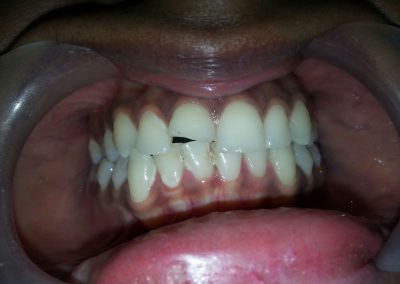CROWNS AND BRIDGES


CROWNS AND BRIDGES
All Metal Crown- Metals used in crowns include gold alloy, other alloys (for example, palladium) or a base-metal alloy (for example, nickel or chromium). Compared with other crown types, less tooth structure needs to be removed with metal crowns, and tooth wear to opposing teeth is kept to a minimum. Metal crowns withstand biting and chewing forces well and probably last the longest in terms of wear down. Also, they rarely chip or break. The metallic color is the main drawback. Metal crowns are a good choice for out-of-sight molars.
Metal Ceramic Crowns- Another name for this is a ‘porcelain fused to metal’ crown. They consist of a metal interior or base which is fused to porcelain crowns. The metal interior can be produced from a range of metals and this is what gives this crown its strength.
These are a traditional type of crown often used in Single crowns, crown and bridge cases. This type of crown is both robust and long lasting.
Disadvantage- The ceramic layer fused with metal can chip off; presence of metal underneath interferes with exact shade matching.
All Ceramic Crowns- These are a type of cosmetic crown which are made purely from ceramic and no other material. The defining feature of these crowns is that they are made from a translucent material which is attractive to look at and blends in well with the rest of your teeth. This means a top quality crown which will last for many years. The majority of all ceramic crowns are produced using computer technology, e.g. CAD/CAM technology which is based upon 3D design.
This crown is considered to be the best match with your own natural teeth. The transparent color and lifelike shape ensures that it is unlikely to be noticed amongst your own natural teeth. There is no metal alloy base with this crown which means no unsightly looking grey line around the gum line. They are strong, long lasting and unlikely to crack or fracture as compared to many other types of crowns. They are considered to be at less risk of chipping.
Disadvantage- The only disadvantage is to do with the cost.
Bridges
this is another form of dental treatment for missing teeth which can be considered alongside a dental implant. It involves the use of synthetic teeth or restorations which are attached to natural teeth as a way of closing the gap caused by a missing tooth.
Many people lose a tooth or two and do not give it much thought but it is important that missing teeth are replaced to prevent the remaining teeth from shifting over towards the gap which then affects facial appearance.
A bridge is a dental structure which consists of a false tooth – known as a Pontic which lies between two crowns. These crowns help to secure the Pontic in place, effectively bridging the gap left by a missing tooth.
The Pontic sits in the gap and the two crowns fit over natural teeth on each side of this gap. This helps to support these teeth and prevents them from leaning into the gap. A bridge can be fabricated from a variety of materials which includes gold, ceramic or alloys.
CONTACT US
Make An Appointment
No. 1, Jain Nagar
Old Delhi Road, Ambala City
85718-85718
Call us today!
Email us
dentistambala@gmail.com
Working Hours
Mon - Fri: 8:00 - 17:00
